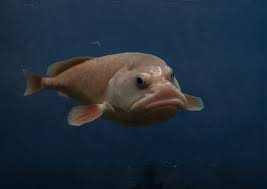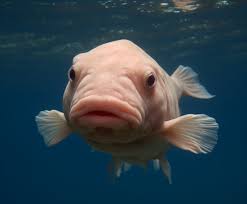
The fish family Psychrolutidae (commonly known as blobfishes, south america river teacher, flathead sculpins, or tadpole sculpins contains over 35 recognized species in 8 genera. This family consists of bottom-dwelling marine sculpins shaped like tadpoles, with large heads and bodies that taper back into small, flat tails.
The skin is loosely attached and movable, and the layer underneath it is gelatinous. The eyes are placed high on the head, focused forward closer to the tip of the snout. Members of the family generally have large, leaf-like pectoral fins and lack scales, although some species are covered with soft spines. This is important to the species as the depths in which they live are highly pressurized and they are ambush/opportunistic/foraging predators that do not expend energy unless they are forced to.

The blobfish has a short, broad tongue and conical teeth that are slightly recurved and are arranged in bands in irregular rows along the premaxillaries; canines are completely absent. Teeth are nonexistent on the palatines and vomer; which make up the hard palate. The blobfish also has a set of specialized pharyngeal teeth that are well developed and paired evenly along the upper and lower portions of the pharyngeal arch.
These specialized teeth may aid in the breakdown of food due to the very strategic dependency on whatever food falls from above.